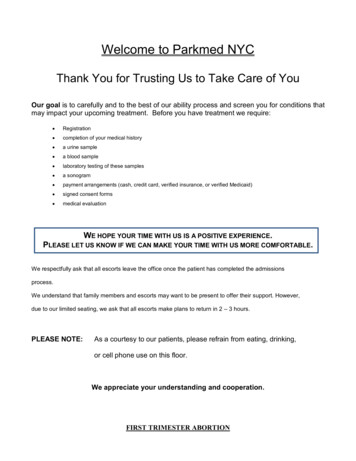
Transcription
Welcome to Parkmed NYCThank You for Trusting Us to Take Care of YouOur goal is to carefully and to the best of our ability process and screen you for conditions thatmay impact your upcoming treatment. Before you have treatment we require: Registration completion of your medical history a urine sample a blood sample laboratory testing of these samples a sonogram payment arrangements (cash, credit card, verified insurance, or verified Medicaid) signed consent forms medical evaluationWE HOPE YOUR TIME WITH US IS A POSITIVE EXPERIENCE.PLEASE LET US KNOW IF WE CAN MAKE YOUR TIME WITH US MORE COMFORTABLE.We respectfully ask that all escorts leave the office once the patient has completed the admissionsprocess.We understand that family members and escorts may want to be present to offer their support. However,due to our limited seating, we ask that all escorts make plans to return in 2 – 3 hours.PLEASE NOTE:As a courtesy to our patients, please refrain from eating, drinking,or cell phone use on this floor.We appreciate your understanding and cooperation.FIRST TRIMESTER ABORTION
We appreciate your visit to Parkmed NYC. The following information is for your benefit. If you have any further questions,please present them at the time of your counseling session.The total time for this treatment is usually 5-10 minutes. Once inside the treatment room you will meet your personal nurse,physician, and anesthesiologist or nurse anesthetist. Your physician will answer any questions you have. You will sit on theexam table, lie back and place your legs in stirrups, similar to the position for a regular GYN examination. Your physician willperform a bimanual exam (i.e. place 2 fingers in the vagina and feel your uterus). An instrument (a speculum) is placed insideyour vagina and adjusted to hold the sides apart so that the physician can see your cervix (the mouth of your uterus).The physician needs to open your cervix in order to remove the pregnancy. Dilators, which are a series of rod or tube shapedinstruments that start very narrow and increase in thickness, are used to do this stretching. They are gently slid into the openingof your cervix, one after the other, until the opening is wide enough for the treatment to be performed.When the opening has been widened enough, the physician will insert a tube or vacurette into your uterus. This tube isconnected to a suction device that creates a vacuum; the contents of your uterus are aspirated out through the tube and collected.Subsequently the tube is removed. Sometimes the suctioning needs to be repeated briefly.If you have elected to have the Manual Vacuum Aspiration (MVA), a local anesthesia is injected into the cervix is to numb thearea. A thin tube is then passed through the cervix. This tube is attached to a handheld plastic device which resembles a largesyringe. This device creates a manual vacuum which aspirates the pregnancy out of the uterus similar to its electricalcounterpart. During this treatment you are awake and may experience cramps as the injection is given, as well as during theaspiration procedure. Pain medication will be given to alleviate the discomfort.Contrary to popular belief, the MVA exerts the same gentle suction as the electric vacuum aspiration. The main difference isin the way the vacuum is generated, which does not change the safety or effectiveness of either procedure. Patients normallychoose the MVA when they elect to stay awake for the treatment, as it is more silent and allows the patient to relax more duringthe treatment while awake.When the physician has finished, the speculum is removed, your legs are lowered and you will remain lying on your back asyou are wheeled to the recovery room. You may bleed off and on for the next 3 weeks. Some patients have no bleeding andthis is considered normal.In the changing room your condition will be observed and monitored. After a satisfactory recovery, which usually takesbetween 20-60 minutes, you will be transferred to a sitting area and then dress. You will be individually counseled by a nurseand given final instructions before leaving.Sedation: An intravenous catheter is inserted into an arm or hand vein and then attached to plastic tubing that delivers fluidfrom a bag. The sedation medication specialist will inject medication into the IV tubing. The sedation medication starts towork instantly. After the sedation medication is discontinued, you will wake up very quickly, but will probably feel groggyfor a short while.Possible Problems: Some mild side effects can be expected from the sedation such as burning at the IV site,swelling at the IV site, coughing, nausea and vomiting. Rarely, while under anesthesia it is possible to regurgitate yourstomach contents into your lungs, causing a pneumonia that requires hospitalization. There is also the possibility of acomplication leading to the need for further surgery including but not limited to removal of the uterus and even leadingto death. You can minimize your risk of this occurring if you do not eat or drink anything after midnight before yourprocedure.Even more rarely, depending on your weight, medical history, and other factors that your anesthesiologist can explainto you, it is possible to stop breathing while under sedation. Usually it is easy to provide oxygen to you while you areasleep, but depending on your weight and other factors, it may be necessary to use a breathing tube or other life-savingintervention in the rare instance that you are unable to breathe on your own.Local Anesthesia: After insertion of the intravenous catheter by the anesthesiologist, local anesthesia is injected with afine needle into the cervix before the physician begins the procedure. This might be experienced as one or two
pinching sensations. The sedation medication is in the same family as novocaine. It will cause a numbing sensation in the areaof the cervix, but it will not affect the uterus. If you wish, you may also request IV sedation.Possible Problems: Some people are allergic to the type of drug used for local anesthesia and they may have areaction. Sometimes after requesting local anesthesia, patients find that they really aren't up to being awake duringthe abortion and request a switch to sedation. This can be done as long as it is safe to make the change. The minorrisks include sore or scratchy throat, hoarse voice, upset stomach, feeling tired, injury to mouth lips or teeth, temporarynerve injury as well as feeling "different" from your normal self, and amnesia. Also, for the next 12-24 hours, youmust not drive, operate machinery, or make important decisions. Major risks include, but are not limited to, brain ornerve injury, stroke, seizure, phlebitis, allergic reaction, cardiovascular and respiratory compromise, heart attack,dangerous heart rhythms, asthmatic attack and even death. The risks associated with local anesthesia include but arenot limited to discomfort on administration, ringing ears, metallic taste, dizziness, racing heart. I am especially alertedto the dangers of having eaten or had anything to drink in the eight hours before having sedation and of travelingimmediately after sedation without a responsible escort. If there is any chance of danger to the patient, some otherplan will be considered.POINTS TO CONSIDERInfection: If unwanted bacteria enter the uterus, an infection can develop. You may experience symptoms like fever andpain in your pelvic area. Antibiotics are usually very effective as treatment. It is unlikely, but possible, that hospitalizationmay be needed to treat the infection.Incomplete Abortion: Since the surgeon cannot see inside the uterus, it is possible to end the pregnancy but notcompletely empty the uterus. If tissue remains it can lead to infection, hemorrhage, or both. It may be necessary to repeat partof the abortion in order to remove the tissue. Symptoms may not occur until several days later when you are at home. It isvery unlikely, but possible, that this could also lead to a need for additional treatment.Cervical Tear: The opening of the uterus at the cervix can be slightly torn during an abortion and may require severalstitches and/or further treatment to repair.Perforation: The wall of the uterus can be penetrated by one of the instruments used in performing an abortion. This canresult in an opening that goes undetected and heals on its own. It can also result in a larger opening, requiring hospitalizationfor completion of the abortion and repair of the uterus. It is possible, that this problem could result in major surgery, (includingremoval of the uterus, or hysterectomy, which would mean that you could never have children afterward).Hemorrhage: Sometimes the bleeding after an abortion is heavier than expected and requires additional care. You mayneed to take medication to promote contraction of the uterus. Re-aspiration of the inside of the uterus might be needed.(Sometimes a transfusion may be indicated to replace significant blood loss). If the bleeding is very severe and cannot becontrolled by other means, surgery may be needed. Such surgery could possibly include removal of the uterus and an end tofuture childbearing.Emotional Issues: Emotional issues after abortion are uncommon. Serious psychiatric disturbance, i.e., psychosis orserious depression after an abortion, appear to occur less frequently than after childbirth. Deciding whether to have an abortionis a very personal matter. You need to be comfortable with the decision that having an abortion is your choice. Personnel areavailable to help you be sure that you make the best decision for your situation.Future Childbearing: Having an uncomplicated abortion does not interfere with a woman's ability to become pregnantin the future. While complications are rare, Parkmed NYC has arrangements with a fully accredited teaching hospital nearbyif a patient must be transferred from the clinic. Because problems sometimes do not show up immediately, you will be carefullyinstructed on what symptoms to watch for that might be a sign of trouble. In addition, Parkmed NYC provides 24 hour, sevenday a week, telephone access for advice if you are concerned that anything is wrong. Please be sure to call us with anypsychological or medical questions. We urge you to call us before going to any hospital or emergency department so that wecan provide proper medical advice and instructions.
Patient RightsTHE PATIENT HAS THE FOLLOWING RESPONSIBILITIES: To provide the center with accurate medical information. To ask all questions you may have regarding the treatment provided by the office. To consent by free will to all medical treatments. To tell us if you do not understand medical procedures or instructions. To follow aftercare instructions as recommended by the office. To contact Parkmed with post-procedure questions or concerns. To pay all fees in the required manner prior to services rendered and accept personal financial responsibility for charges notcovered by insurance. To observe the center’s policies and regulations, including those pertaining to conduct. To keep appointments as scheduled, or advise the center if unable to keep appointment. To inform Parkmed if you have a Living Will, Medical Power of Attorney, or any other Healthcare directive. To bring an escort to accompany him/her and remain for 24 Hours if required by Parkmed.THE PATIENT HAS THE RIGHT TO: Understand and use these rights. If for any reason you do not understand or you need help, the facility must provide assistance,including an interpreter. Receive services without regard to age, race, color, sexual orientation, religion, marital status, sexual orientation, national origin,disability or source of payment. Be treated with consideration, respect and dignity including privacy in treatment. Be informed of the services available at the Office in a clean, safe environment free of unnecessaryrestraints. Receive emergency care if you need it. Be informed of the provisions for off-hour emergency coverage. Be informed of the name and position of the doctor who will be in charge of your care in the facility. Know the name, positions and functions of any facility staff involved in your care and refuse their treatment, examination orobservation. Receive all the information that you need to give informed consent for any proposed treatment. This information shall include thepossible risks and benefits of the treatment. Be informed of the charges for services, eligibility for third-party reimbursements and, when applicable, the availability offree/reduced cost care. Receive an itemized copy of your account statement, upon request. Obtain from your health care practitioner, or the health care practitioner’s delegate, complete and current information concerningyour diagnosis, treatment, and prognosis in terms the patient can be reasonably expected to understand which allows for participationin treatment when indicated. Refuse treatment to the extent permitted by law and to be fully informed of the medical consequences of your action. You may selectanother provider if one is available. Refuse to participate in experimental research with a full explanation. Voice grievances and recommend changes in policies and services to the center’s staff, the operator and the New York StateDepartment of Health without fear of reprisal. Contact the New York State Department of Health to voice concerns at 800-804-5447 433 River Street, 6thFloor Troy, NY 12180 orMedicare Ombudsman @ www.medicare.gov. Express complaints about the care and services provided and to have the center investigate such complaints. Privacy while in the facility and confidentiality of all information and records regarding your care. Approve or refuse the release or disclosure of the contents of your medical record to anyhealth care practitioner and/or health carefacility except as required by law or third party payment contract. Access your medical record pursuant to the provisions of the law. Receive information about advance directives. Delegate an individual to give consent for an order not to resuscitate if you are too ill to do so. Receive information about the credentialing of our healthcare providers
Second Trimester AbortionWe appreciate your visit to Parkmed. The following information is for your benefit. If you have any furtherquestions, please present them at the time of your information session.How it is Done – Laminaria Insertion: The total time for this treatmentis usually 5-10 minutes. Onceinside the examination room you will meet your personal nurse and have any questions answered by yourphysician. You will sit on the exam table, lie back and place your legs in stirrups, similar to the position fora regular GYN examination. As deemed necessary by the Physician and based on the size of the pregnancy,you will be given sedation and an ultrasound guided injection of Potassium Chloride or Digoxin will beadministered either to the fetus or into the uterine cavity if your pregnancy is between 18 and 24 weeks.This injection will stop the fetal heart and cause fetal death. An instrument (a speculum) is placed insideyour vagina and adjusted to hold the sides apart so that the physician can see your cervix (the mouth ofyour uterus). Another instrument is then used to hold your cervix in place while laminaria are inserted. Thelaminaria are made of a dried, compressed, plant substance. This material has the ability to absorb manytimes its own volume in moisture from your body. As the laminaria gradually absorb this moisture, theyslowly enlarge and gently stretch the opening of your cervix to provide an outlet large enough to removethe pregnancy. While it will only take a few minutes to insert the laminaria, they must remain in yourcervix for many hours to work effectively.The number of laminaria you will need depends upon several factors. The physician will use his or herexperience and judgment as well as clinical guidelines to decide how many laminaria will work best foryou.You may experience some contractions as the laminaria are eased into the cervix. However, the process isbrief and the cramping should subside in a short time (usually within 15-30 minutes). Some gauze will beplaced high up in your vagina after inserting the laminaria. When the physician is finished, the speculum isremoved, your legs are lowered, and you will be able to get off the exam table after a few moments.If your pregnancy is more advanced in the second trimester, you may need to have the laminaria insertiondone in stages to open your cervix adequately without causing injury to your cervix. While it is usuallypossible to know this in advance, it isn't always predictable. Keep in mind that it is in your best interest thatrepeat insertions are performed so that damage to your cervix can be avoided.Before you leave, you will receive instructions on when to return to the clinic, what to expect during theperiod when the laminaria are in place, and how to care for yourself to prevent complications and tomanage any problems. Once the laminaria are inserted, the cervix begins to stretch and the abortion hasbegun. You cannot change your mind about having the abortion once laminaria are inserted.How it is Done - The Abortion Treatment: The total time for this treatment is usually between 5-30minutes. Once inside the examination room you meet your personal nurse and have any questions answeredby your physician. After this, you sit on the exam table, lie back and place your legs in stirrups, similar tothe position for a regular GYN examination. Sedation will be administered by a specialist who will staywith you during the entire treatment. An instrument called a speculum is placed inside your vagina andadjusted to hold the sides apart so that the physician can see your cervix (the mouth of your uterus).Another instrument is then used to hold your cervix in place throughout the treatment.The physician will remove the laminaria. This will enable them to have access to the inner part of youruterus. Suction will be applied to remove amniotic fluid and fetal tissue. Thereafter, when necessary,forceps will be used to crush and fragment remaining fetal body inside the uterus. These steps will facilitateremoval of fetal tissue through the cervix. When necessary, suctioning inside the uterus may be performedto remove any remaining tissue.
When the physician has finished, the speculum is removed. Upon completion of the treatment, you will betransported to the changing room. You may experience bleeding that may be similar to the flow of a normalperiod but can be heavier and can occur off and on for up to 3 weeks. Some patients experience no bleedingpost-treatment.In the changing room your condition will be observed and monitored. After a satisfactory recovery, whichusually takes between 20-60 minutes, you will be transferred to a sitting area and then dress. You will beindividually counseled by a nurse and given final instructions before leaving.Sedation: An intravenous catheter is inserted into an arm or hand vein and then attached to plastic tubingthat delivers fluid from a bag. The anesthesiologist will inject medication into the IV tubing. The sedationstarts to work instantly. After the sedation is discontinued, you will wake up very quickly, but will probablyfeel groggy for a short while.Possible Problems: Some mild side effects can be expected from the sedation such as burning at the IVsite, swelling at the IV site, coughing, nausea and vomiting. Rarely, while under sedation it is possible toregurgitate your stomach contents into your lungs, causing a pneumonia that requires hospitalization. Youcan minimize your risk of this occurring if you do not eat or drink anything after midnight before yourtreatment. In addition, there is a possibility of mental impairment after sedation. The office prohibits thepatient to operate heavy machinery, drive a vehicle or make any important decision post sedation.Even more rarely, depending on your weight, medical history, and other factors that your anesthesiologistcan explain to you, it is possible to stop breathing under sedation. Usually it is easy to provide oxygen toyou while you are asleep, but depending on your weight and those other factors, it may be necessary to usea breathing tube or other life-saving intervention in the rare instance that you are unable to breathe on yourown.Local Anesthesia: After insertion of the intravenous catheter by the anesthesiologist, local anesthesia isinjected with a fine needle into and around the cervix before the physician begins the treatment. This mightbe experienced as one or two pinching sensations. The anesthetic is in the same family as Novocain. It willcause a numbing sensation in the area of the cervix, but it will not affect the uterus. Some sensation ofcramping will be present.Possible Problems: Some people are allergic to the type of drug used for local anesthesia and they mayhave a reaction. Sometimes after requesting local anesthesia patients find that they really aren't up to beingawake and aware during the abortion treatment and request a switch to sedation. This can be done as longas it is safe to make the change. If there is any chance of danger to the patient, some other plan will beconsidered.Points to Consider about Second Trimester AbortionsSecond trimester abortion is a safe treatment. In comparison to abortions done before twelve weeks ofpregnancy, the theoretical risks are greater and statistically increase as the pregnancy advances in age. Thisis due to several factors: The treatment takes longer. The cervix must be dilated in advance so there is more opportunity for infection. The use of the osmotic cervical laminaria can set off a miscarriage before the patient returns to the office,which is an uncontrolled situation that can lead to hemorrhage. The pregnancy is larger and more difficult to remove, which increases the chance of injuring the uterus. The walls of the uterus are thinner due to increased stretching to accommodate the larger pregnancy.Although abortion is one of the safest female treatments, like any patient having surgery or any woman inchildbirth, you must accept that there is always the chance of a complication. The risk of death during anabortion treatment is very small, with the risks being less than that of childbirth.
Infection: If unwanted bacteria enter the uterus, an infection can develop. You may experience symptomslike fever and pain in your pelvic area. Antibiotics are usually very effective as treatment. It is unlikely, butpossible, that hospitalization may be needed to treat the infection.Incomplete Abortion: Since the surgeon cannot see inside the uterus, it is possible to end the pregnancybut not completely empty the uterus. If tissue remains it can lead to infection, hemorrhage, or both. It maybe necessary to repeat part of the abortion treatment in order to remove the tissue. Symptoms may not occuruntil several days later when you are at home. It is very unlikely, but possible, that this could also lead to aneed for additional surgery.Cervical Tear: The opening of the uterus at the cervix can be slightly torn during an abortion treatmentand may require several stitches and/or surgery to repair.Perforation: The wall of the uterus can be penetrated by one of the instruments used in performing anabortion. This can result in an opening that goes undetected and heals on its own. It can also result in alarger opening, requiring hospitalization for completion of the abortion and repair of the uterus. It ispossible, that this problem could result in major surgery, (including removal of the uterus, hysterectomy,which would mean that you could never have children afterward).Hemorrhage: Sometimes the bleeding after an abortion is heavier than expected and requires additionalcare. You may need to take medication to promote contraction of the uterus. Re-aspiration of the inside ofthe uterus might be needed. (Sometimes a transfusion may be indicated to replace significant blood loss). Ifthe bleeding is very severe and cannot be controlled by other means, surgery may be needed. Such surgerycould possibly include removal of the uterus and an end to future childbearing.Emotional Problems: Emotional problems after abortion are uncommon. Serious psychiatric disturbance,i.e., psychosis or serious depression after an abortion, appear to occur less frequently than after childbirth.Deciding whether to have an abortion is a very personal matter. You need to be comfortable with thedecision that having an abortion is your choice. Patient Facilitators are available to help you be sure thatyou make the best decision for your situation.Future Childbearing: Having an uncomplicated abortion does not interfere with a woman's ability tobecome pregnant in the future. While complications are rare, Parkmed has arrangements with a fullyaccredited teaching hospital nearby if a patient must be transferred from the clinic. Because problemssometimes do not show up immediately, you will be carefully instructed on what symptoms to watch forthat might be a sign of trouble. In addition, Parkmed provides 24 hour, seven days a week, telephone accessfor advice if you are concerned that anything is wrong. Please be sure to call us with any psychological ormedical questions. We urge you to call us before going to any hospital or emergency department so that wecan provide proper medical advice and instructions.Important Considerations: Once the abortion treatment has been started severe life-threateningcomplications, including death, can occur if you do not return to the facility to have the abortion treatmentcompleted.Once laminaria have been inserted, extended delay in completion of the treatment can result in infection,miscarriage, hemorrhage, and death.With Potassium Chloride or Digoxin injection fetal death usually occurs, which makes the treatment saferfor you on the following day, by reducing risks associated with a second trimester treatment. If you fail toreturn to the office at the date and time recommended by the surgeon, severe life-threatening consequenceswill occur. In the event of Potassium Chloride or Digoxin injection failure, severe malformations and lifelong injury will occur to the fetus. These include, but are not limited to, stillbirth, brain damage, heartdamage, lung damage, intestinal damage and paralysis. All of these conditions will be irreversible.
CERVICAL LAMINARIA INFORMATION SHEETOnce the laminaria are inserted, your cervix begins to stretch and the abortion process has begun. Placement ofthe laminaria opens the cervix. In order to prevent infections, the pregnancy needs to be removed from the uteruswithin a limited time frame. It important for your health that you return to the office the day after the laminariaare inserted. It also makes it extremely risky for your health not to have the abortion after the laminaria areinserted.After insertion, it is normal for you to have lower abdominal, period-like cramps. There may also be bleeding. Youmay feel nauseous. These symptoms are very common. You may take the following medications to help with thecramping: Ibuprofen 600mg every 6 hours, or if you are allergic use:1-2 Extra Strength Tylenol every 4 to 6 hoursRemember not to take anything by mouth after midnight.After the laminaria are inserted, gauze is placed inside the vagina to help keep them in place. Sometimes the gauzeand/or laminaria may fall out before you return to the office. If this happens, please inform us upon your return. Itis not necessary to contact us by telephone if your laminaria and/or gauze fall out.Some patients will experience rupture of their membranes prior to the procedure. If this occurs in conjunction withlabor-like timed uterine contractions, contact us immediately. If you are not having any other signs or symptoms,please notify us when you return in the morning.There is always a trained professional on-call to help answer questions and provide advice. Please call us if youhave any of the following symptoms: Bleeding that completely soaks one maxi-sized pad in one hour or lessFever greater than 100.4 F for more than 8 hours. (Remember that eating, drinking, smoking, chewinggum, or brushing your teeth within 30 minutes of taking your temperature orally will give you a falsereading).Labor-like timed uterine contractions (with or without ruptured membranes)Miscarriage of the pregnancyYou may take showers but no tub baths after the laminaria are inserted. You should not place anything inside yourvagina.Your return appointment is scheduled for tomorrow morning at 7:30AM. Please be on time.PLEASE REMEMBER NOT TO EAT OR DRINK ANYTHING AFTER MIDNIGHT TONIGHT.Patient SignaturePLEASE CALL THE PARKMED NYC HOTLINE AT 800-346-5111IF YOU HAVE ANY QUESTIONS OR CONCERNS.
serious depression after an abortion, appear to occur less frequently than after childbirth. Deciding whether to have an abortion is a very personal matter. You need to be comfortable with the decision that having an abortion is your choice. Personnel are available to help you be sure that you make the best decision for your situation.










